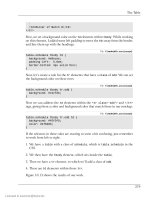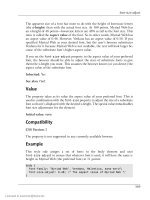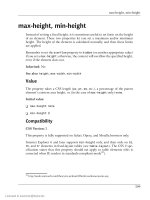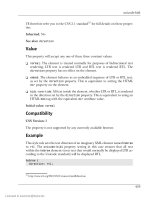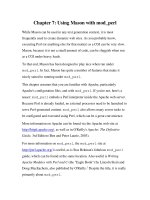HTML Utopia: Designing Without Tables Using CSS- P16
Bạn đang xem bản rút gọn của tài liệu. Xem và tải ngay bản đầy đủ của tài liệu tại đây (425.71 KB, 30 trang )
richness
Example
This example uses double quotes for the first (outermost) level of quotes, then
single quotes for the second level (and presumably for all deeper levels). This
setting is applied to the body element (it is inherited by all nested elements),
then quotes are added to blockquote and q (inline quote) elements:
body {
quotes: '"' '"' "'" "'";
}
blockquote:before, q:before {
content: open-quote;
}
blockquote:after, q:after {
content:close-quote;
}
richness
For use by aural (speaking) browsers for the visually impaired, this property
controls richness/smoothness in the voice that reads a selected element’s content
aloud (which affects the degree to which the sound “carries”).
Inherited: Yes
See also: pitch, pitch-range, stress, voice-family, volume
Value
The property takes any integer between 0 and 100, where 0 is a soft, mellifluous
voice, 50 is an average speaking voice, and 100 is a strident voice.
Initial value: 50
Compatibility
CSS Version: 2
The property is not supported by any currently available browser.
429
Licensed to
Appendix C: CSS Property Reference
Example
This example causes aural browsers to speak elements of class ominous more
softly than usual:
.ominous {
richness: 30;
}
right
This property lets you set the distance between the right edge of an absolute
positioned element (including its padding, border, and margin) and the right
edge of the positioning context in which it resides. The positioning context is the
padding area of the element’s nearest ancestor that has a position property value
other than static, or the body element.
For relative positioned elements, this property sets a relative offset from the
normal position of its bottom edge. So a setting of 10px will shift the right edge
of the box ten pixels to the left, and a setting of -10px will shift it right by the
same amount.
Inherited: No
See also: position, bottom, left, and top
Value
This property takes a CSS length measurement, a percentage value, or the auto
constant. Percentages are based on the width of the parent element. The auto
constant tells the browser to determine the position of the right edge itself, based
on whatever other constraints may exist on the size/position of the element.
Initial value: auto
Compatibility
CSS Version: 2
The property works in all CSS-compatible browsers.
430
Licensed to
ruby-align
Often, the same effect can be achieved by setting the left property of a box.
Since left is supported by more browsers than right, this should be done
whenever possible.
Example
This style rule positions the element with ID menu against the right edge of the
document (assuming it is in the body’s positioning context):
#menu {
position: absolute;
right: 0;
width: 100px;
height: 200px;
}
ruby-align
Ruby text is a new addition in the XHTML 1.1 recommendation and is described
by the Ruby Annotation Recommendation37 of the W3C. Commonly used in
Japan and China, ruby text generally appears in a smaller font that overlays the
main text as a pronunciation guide, or to provide some other explanatory annota
tion. It has no relation to the Ruby programming language, other than the fact
that they both originated in Japan.
This property sets how the ruby text is aligned with the base text.
Inherited: No
See also: ruby-overhang, ruby-position
Value
This property accepts any of the following constants:
❑ auto
❑ center
❑ distribute-letter
37
/>
431
Licensed to
Appendix C: CSS Property Reference
❑ distribute-space
❑ left
❑ line-edge
❑ right
For the meanings of each of these constants, see the CSS3 Ruby module working
draft38 and the Microsoft Internet Explorer documentation for this property.39
Initial value: auto
Compatibility
CSS Version: n/a
This property is supported only in Internet Explorer for Windows version 5 or
later. In that browser, this property must be applied to the ruby element that
contains the ruby text (rt) element for which you wish to set the alignment.
Equivalent functionality is planned for inclusion in CSS3, and the current
working draft suggests that this property will be as documented here. To follow
the work on this front, see the CSS Working Group web site.40
Example
This style rule centers ruby text over the base text:
ruby {
ruby-align: center;
}
ruby-overhang
Ruby text is a new addition in the XHTML 1.1 recommendation and is described
by the Ruby Annotation Recommendation41 of the W3C. Commonly used in
Japan and China, ruby text generally appears in a smaller font that overlays the
38
/> /> />41
/>39
40
432
Licensed to
ruby-overhang
main text as a pronunciation guide, or to provide some other explanatory annota
tion.
This property controls whether ruby text is allowed to extend over adjacent text
or whitespace, if it is longer than the base text it annotates.
Inherited: No
See also: ruby-align, ruby-position
Value
This property accepts any of the following constants:
❑ auto
❑ none
❑ whitespace
For the meanings of each of these constants, see the CSS3 Ruby module working
draft42 and the Microsoft Internet Explorer documentation for this property.43
Initial value: auto
Compatibility
CSS Version: n/a
This property is supported only in Internet Explorer for Windows version 5 or
later. In that browser, this property must be applied to the ruby element that
contains the ruby text (rt) element for which you wish to set the alignment.
Equivalent functionality is planned for inclusion in CSS3, and the current
working draft suggests that this property will be as documented here. To follow
the work on this front, see the CSS Working Group web site.44
42
/> />44
/>43
433
Licensed to
Appendix C: CSS Property Reference
Example
This style rule allows ruby text to overhang whitespace adjacent to the base text
only:
ruby {
ruby-overhang: whitespace;
}
ruby-position
Ruby text is a new addition in the XHTML 1.1 recommendation and is described
by the Ruby Annotation Recommendation45 of the W3C. Commonly used in
Japan and China, ruby text generally appears in a smaller font that overlays the
main text as a pronunciation guide, or to provide some other explanatory annota
tion.
This property controls where the ruby text is positioned in relation to its base
text.
Inherited: No
See also: ruby-align, ruby-overhang
Value
In Internet Explorer for Windows version 5 or later, this property accepts the
following constants:
❑ above
❑ inline
However, the current working draft of CSS3 proposes the following values:
❑ after
❑ before
❑ right
45
/>
434
Licensed to
scrollbar-base-color
For the meanings of each of these sets of constants, see the Microsoft Internet
Explorer documentation for this property46 and the CSS3 Ruby module working
draft,47 respectively.
Initial value:
❑ Internet Explorer: above
❑ CSS3 draft: before
Compatibility
CSS Version: n/a
This property is supported only in Internet Explorer for Windows version 5 or
later. In that browser, this property must be applied to the ruby element that
contains the ruby text (rt) element for which you wish to set the alignment.
Equivalent functionality is planned for inclusion in CSS3, but the proposed
property values differ from those supported by Internet Explorer for Windows.
To follow the work on this front, see the CSS Working Group web site.48
Example
This style rule places ruby text inline with, instead of above, the base text in In
ternet Explorer for Windows:
ruby {
ruby-position: inline;
}
scrollbar-base-color
This nonstandard property is provided by Internet Explorer for Windows version
5.5 or later to let the page designer control the overall color of the scroll bar(s)
associated with an element. The browser will use the specified color as a basis
for choosing the actual colors of all the parts of the scroll bars.
46
/>
/>
48
/>
47
435
Licensed to
Appendix C: CSS Property Reference
The colors of individual parts of the scroll bars can be controlled precisely with
the scrollbar-element-color properties.
Inherited: Yes
See also: scrollbar-element-color
Value
The property takes any CSS color value. See Appendix B.
Initial value: depends on user configuration
Compatibility
CSS Version: n/a
This nonstandard property works only in Internet Explorer for Windows version
5.5 or later.
Example
This style rule sets the overall scroll bar color to blue on textarea elements:
textarea {
scrollbar-base-color: blue;
}
scrollbar-element-color
This collection of nonstandard properties is provided by Internet Explorer for
Windows version 5.5 or later to let the page designer control the colors of various
parts of the scroll bar(s) associated with an element. The actual property names,
along with their meanings, are listed in Table C.9.
436
Licensed to
scrollbar-element-color
Table C.9. Internet Explorer scrollbar properties
Property
Affected area(s)
scrollbar
3dLight-color
outer top and left edges of the scroll bar buttons and thumb
scrollbar-arrow
color
up and down arrows in the scroll bar buttons
scrollbar-darkShadow-color
outer right and bottom edges of the scroll bar buttons and
thumb
scrollbar-face
color
interior areas of the scroll bar buttons and thumb
scrollbar-high
light-color
inner top and left edges of the scroll bar buttons and thumb
scrollbar-shadow inner right and bottom edges of the scroll bar buttons and
color
thumb
scrollbar-track
color
background of the scroll bar, outside the scroll bar buttons
and thumb
Inherited: Yes
See also: scrollbar-base-color
Value
The property takes any CSS color value. See Appendix B.
Initial values: depend on user configuration
Compatibility
CSS Version: n/a
These nonstandard properties work only in Internet Explorer for Windows version
5.5 or later.
Example
This style rule removes the three-dimensional appearance of the scroll bars around
textarea elements, displaying them in flat black and white instead:
437
Licensed to
Appendix C: CSS Property Reference
textarea {
scrollbar-3dLight-color: black;
scrollbar-arrow-color: black;
scrollbar-darkShadow-color: black;
scrollbar-face-color: white;
scrollbar-highlight-color: white;
scrollbar-shadow-color: white;
scrollbar-track-color: black;
}
size
This property, which can appear only within an @page at-rule (see the section
called “At-rules” in Appendix A), lets you control the page size and/or orientation
as needed.
Value
This property can take a number of constants, or specific page measurements.
Supported constants are:
❑ auto
❑ landscape
❑ portrait
auto tells the browser to use a page size/orientation equal to the printer settings,
while landscape and portrait force the browser to rotate the page as necessary
to print in the specified orientation on the printer’s paper size.
Alternatively, you can specify an exact page size with either one or two CSS
length values (separated by spaces). If only one value is specified, it is used as
both the width and height; otherwise, the first value is the page width and the
second is the page height.
Initial value: auto
Compatibility
CSS Version: 2
438
Licensed to
speak
The property is not supported by any currently available browser.
Example
This style rule specifies that the page should be printed in landscape orientation
on a Letter-sized (8.5-inch by 11-inch) page:
@page {
size: 11in 8.5in;
}
speak
For use by aural (speaking) browsers for the visually impaired, this property
controls if and how an element’s content should be read aloud.
Inherited: Yes
See also: speak-header, speak-numeral, speak-punctuation
Value
This property accepts any of the following constants:
❑ none: The element’s content is not read.
❑ normal: The element’s content is read normally.
❑ spell-out: The element’s content is spelled out one character at a time.
Initial value: normal
Compatibility
CSS Version: 2
This property is not supported by any currently available browser.
Example
This example causes aural browsers to spell out abbr and acronym elements:
439
Licensed to
Appendix C: CSS Property Reference
abbr, acronym {
speak: spell-out;
}
speak-header
For use by aural (speaking) browsers for the visually impaired, this property
controls how table headers are read. As the browser reads out the contents of
each cell in the table, it can either read all the headers for a cell before that cell’s
contents, or it may read only those headers that are different from the headers
of the previously-read cell.
Inherited: Yes
See also: speak, speak-numeral, speak-punctuation
Value
This property accepts any of the following constants:
❑ always: For each cell, all the headers that apply to it are read first.
❑ once: For each cell, only headers that are different from the previously-read
cell are read.
Initial value: once
Compatibility
CSS Version: 2
This property is not supported by any currently available browser.
Example
This example causes aural browsers to read all the headers that apply to each cell
in a table of class matrix:
table.matrix {
speak-header: always;
}
440
Licensed to
speak-numeral
speak-numeral
For use by aural (speaking) browsers for the visually impaired, this property
controls how numbers are read. A number may be read either as a series of digits
(e.g. “one, two, three”) or as a whole number (e.g. “one hundred twenty-three”).
Inherited: Yes
See also: speak, speak-header, speak-punctuation
Value
This property accepts any of the following constants:
❑ digits: The number is read as a series of digits.
❑ continuous: The number is read as a whole number.
Initial value: continuous
Compatibility
CSS Version: 2
The property is not supported by any currently available browser.
Example
This example causes aural browsers to read numbers occurring in any element of
class binary as a series of digits:
.binary {
speak-numeral: digits;
}
speak-punctuation
For use by aural (speaking) browsers for the visually impaired, this property
controls how punctuation is read. Punctuation may either be read aloud (e.g.
“period”), or represented by pauses in the reading of surrounding text.
441
Licensed to
Appendix C: CSS Property Reference
Inherited: Yes
See also: speak, speak-header, speak-numeral
Value
This property accepts any of the following constants:
❑ code: Punctuation is read aloud.
❑ none: Punctuation is implied by natural pauses.
Initial value: none
Compatibility
CSS Version: 2
This property is not supported by any currently available browser.
Example
This example causes aural browsers to read aloud punctuation occurring in any
element of class spokenpunct:
.spokenpunct {
speak-punctuation: code;
}
speech-rate
For use by aural (speaking) browsers for the visually impaired, this property
controls how quickly (or slowly) the content of an element is read.
Inherited: Yes
See also: pause
Value
You can specify the exact speech rate in words per minute as a positive, floatingpoint number.
442
Licensed to
stress
This property also accepts any of the constants in Table C.10.
Table C.10. speech-rate constants
Constant
Effect
x-slow
80 words per minute
slow
120 words per minute
medium
180 to 120 words per minute
fast
300 words per minute
x-fast
500 words per minute
slower
the inherited rate minus 40 words per minute
faster
the inherited rate plus 40 words per minute
Initial value: medium
Compatibility
CSS Version: 2
This property is not supported by any currently available browser.
Example
This example causes aural browsers to read elements of class ominous more slowly
than usual:
.ominous {
speech-rate: slower;
}
stress
For use by aural (speaking) browsers for the visually impaired, this property
controls stress in the voice that reads a selected element’s content aloud. In
English, for example, every sentence usually contains particular words that are
emphasized more heavily than others. This property controls how great the dif
ference is between emphasized and non-emphasized passages.
Inherited: Yes
443
Licensed to
Appendix C: CSS Property Reference
See also: pitch, pitch-range, richness, voice-family, volume
Value
The property takes any integer between 0 and 100; 50 is an average level of stress.
Initial value: 50
Compatibility
CSS Version: 2
The property is not supported by any currently available browser.
Example
This example causes aural browsers to speak elements of class ominous with
greater stress than usual:
.ominous {
stress: 75;
}
table-layout
This property lets you accelerate table rendering by allowing it to take a shortcut
in calculating the column sizes. When table-layout is set to fixed, the browser
considers only the cells in the first row when determining the table’s cell widths
(and the table’s overall width). This allows the browser to render the table one
row at a time, instead of having to wait for the full table to load before being able
to display any of it.
Be aware that wider content in subsequent table rows will be wrapped to the
column widths set by the first row when the fixed table layout mode is used: the
cell size will not increase to accommodate the data.
Inherited: No
See also: max-height, min-height
444
Licensed to
text-align
Value
auto or fixed
Initial value: auto
Compatibility
CSS Version: 2
This property is supported by all CSS-compatible browsers.
Example
This style rule sets tables of class thumbnails to the quicker, fixed layout mode:
table.thumbnails {
table-layout: fixed;
}
text-align
This property sets the horizontal alignment of text and other inline content
within a block element.
If you’re looking for a way to set the horizontal alignment of a block (e.g. to
center it on the page), you should instead use the margin-left, margin-right,
left, and right properties to achieve the desired effect (e.g. you can center a
block horizontally by setting its left and right margins to auto).
Inherited: Yes
See also: text-align-last, vertical-align
Value
This property supports the following constant values:
❑ center
❑ justify
445
Licensed to
Appendix C: CSS Property Reference
❑ left
❑ right
center, left, and right are self-explanatory. justify should be familiar to users
of word processors; it causes the words on each line to be spaced so that each
line starts and ends against the edge of the content box, with the exception of
the last line.
Initial value: Depends on the language of the browser and/or the element
Compatibility
CSS Version: 1
This property is supported by all CSS-compatible browsers.
In older browsers (most version 4 browsers), justify behaves the same as left;
however, this is allowable under the CSS 2.1 standard.
Example
This style rule will justify text within the body and all child elements, unless
otherwise specified (thanks to inheritance):
body {
text-align: justify;
}
text-align-last
This nonstandard property, supported by Internet Explorer for Windows version
5.5 or later, lets you specifically set the alignment of the last line of text within
a block element whose text-align property is set to justify.
This property is ignored when the text-align property is not set to justify.
Inherited: Yes
See also: text-align
446
Licensed to
text-autospace
Value
This property supports the following constant values:
❑ auto
❑ center
❑ justify
❑ left
❑ right
auto allows the last line to reflect the alignment set by the text-align property.
Initial value: auto
Compatibility
CSS Version: n/a
The property is supported only by Internet Explorer for Windows version 5.5 or
later.
Example
This style rule causes the last line of a blockquote element to be right-aligned:
blockquote {
text-align: justify;
text-align-last: right;
}
text-autospace
This property lets you choose between a number of methods for increasing the
space between ideographic characters (in Asian languages) and non-ideographic
characters (non-Asian languages).
Inherited: No
447
Licensed to
Appendix C: CSS Property Reference
Value
This property accepts any of the following constant values:
❑ ideograph-alpha: extra space between ideographic and non-ideographic
characters
❑ ideograph-numeric: extra space between ideographic and numeric characters
❑ ideograph-parenthesis: extra space between ideographic characters and
parentheses
❑ ideograph-space: extra space between ideographic characters and whitespace
❑ none: no extra space
Initial value: none
Compatibility
CSS Version: n/a
The property is compatible with Internet Explorer 5 or later for Windows only.
Equivalent functionality is planned for inclusion in CSS3, but combinations of
the above values will likely be allowed. To follow the work on this front, see the
CSS Working Group web site.49
Example
This style rule adds extra spacing between ideographic and non-ideographic
characters in paragraphs of class mixed:
p.mixed {
text-autospace: ideograph-alpha;
}
49
/>
448
Licensed to
text-decoration
text-decoration
This property lets you add one or more “decorations” to the text within an ele
ment. Decorations include overlining, underlining, striking through, and blinking.
Although this property is not inherited, specifying it on an element will apply
the decoration through the whole element, including any child elements.
Inherited: No
Value
This property can be set to none to remove any decoration specified in a lowerpriority rule (e.g. to remove the underline applied to hyperlinks in the default
style sheets of visual browsers).
Otherwise, it can take any space-delimited combination of the following constants:
50
❑ blink
❑ line-through
❑ overline
❑ underline
Initial value: none
Compatibility
CSS Version: 1
This property works in all CSS-compatible browsers; however, the blink decora
tion type is (mercifully) not supported in Internet Explorer browsers.
Example
This style rule removes the underline from hyperlinks in the document and re
places it with a dashed bottom border:
50
The author begs you not to use this.
449
Licensed to
Appendix C: CSS Property Reference
a:link, a:visited {
text-decoration: none;
border-bottom: 1px solid dashed;
}
text-indent
This property sets the indent applied to the first line of a block element (and its
children, thanks to inheritance).
A negative value will result in a hanging indent, with the text of the first line
protruding from the content area of the block. You will usually want to balance
a negative text-indent with a positive padding-left value of the same or
greater size to keep all the text within the border of the block.
Inherited: Yes
See also: padding
Value
The property takes any CSS length value (px, pt, em, etc.), or a percentage of the
parent element’s width.
Initial value: 0
Compatibility
CSS Version: 1
This property is supported by all CSS-compatible browsers.
Example
This style rule creates a one-centimeter hanging indent on all paragraphs by using
a negative text-indent in combination with a padding-left value of the same
size:
p {
text-indent: -1cm;
padding-left: 1cm;
}
450
Licensed to
text-justify
text-justify
This nonstandard property, supported by Internet Explorer for Windows version
5 or later, controls the algorithm used to calculate spacing in blocks with
text-align set to justify. This property is designed for use with Asian languages
where “words” do not necessarily occur, and therefore the adaptive word spacing
usually associated with justified text does not have a clear meaning.
Inherited: Yes
See also: text-align, text-kashida-space
Value
This property will accept any one of the following constant values:
❑ auto: allows the browser to choose which algorithm to use
❑ distribute: increases letter spacing and word spacing by the same amount
❑ distribute-all-lines: same as distribute, but also applies to the last line
❑ inter-cluster: same as distribute, but does not add space between char
acters of Southeast Asian grapheme clusters
❑ inter-ideograph: same as distribute, but does not add space between nonChinese/Japanese/Korean characters
❑ inter-word: the familiar method for Latin languages like English; adds only
space between words
❑ kashida: uses elongated strokes in Arabic characters to justify text
❑ newspaper: same as distribute, but preference is given to inter-word spacing
over inter-character spacing
Initial value: auto
Compatibility
CSS Version: n/a
451
Licensed to
Appendix C: CSS Property Reference
The property is available in Internet Explorer 5 or later for Windows only. The
kashida mode is supported only by version 5.5 or later.
Equivalent functionality is planned for inclusion in CSS3, but final property
names and values are likely to differ. To follow the work on this front, see the
CSS Working Group web site.51
Example
This style rule specifies the newspaper justification mode for div elements of
class column:
div.column {
text-align: justify;
text-justify: newspaper;
}
text-kashida-space
This nonstandard property, supported by Internet Explorer for Windows version
5.5 or later, controls the degree to which the browser relies on kashida expansion
to achieve justified alignment. This property is designed for use with Arabic lan
guages, where certain horizontal lines in the script can be extended to lengthen
words.
For this property to have a useful effect, affected elements must have their
text-align property set to justify, and their text-justify property set to a
mode that allows kashida expansion (auto, distribute, kashida, or newspaper).
Inherited: Yes
See also: text-align, text-justify
Value
The property takes as its value a percentage ratio between kashida expansion and
whitespace expansion, where 100% will result in only kashida expansion and 0%
will result in only whitespace expansion.
Initial value: 0%
51
/>
452
Licensed to
text-overflow
Compatibility
CSS Version: n/a
This property is supported by Internet Explorer 5.5 or later for Windows only.
Equivalent functionality is planned for inclusion in CSS3, but final property
names and values are likely to differ. To follow the work on this front, see the
CSS Working Group web site.52
Example
This style rule specifies that for every two units of whitespace that are added,
one unit of kashida expansion is added:
div.column {
text-align: justify;
text-kashida-space: 33%;
}
text-overflow
This nonstandard property, supported by Internet Explorer 6 or later, lets you
handle text that is clipped by the width of an element more elegantly. The portion
of the string that would normally overflow the edge of the box is replaced with
an ellipsis (…).
The element must have its overflow property set to something other than visible
(although hidden is the only value that really makes sense) for this property to
have any effect.
Note that this property affects only text that is clipped by the width of the element
(or the height in vertical writing systems), either because word-wrapping is disabled
with the white-space property, or because a long word or other non-wrappable
text segment is too long to fit in the box.
Inherited: No
See also: overflow, white-space, width
52
/>
453
Licensed to

